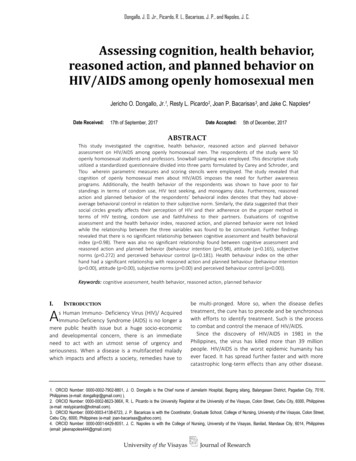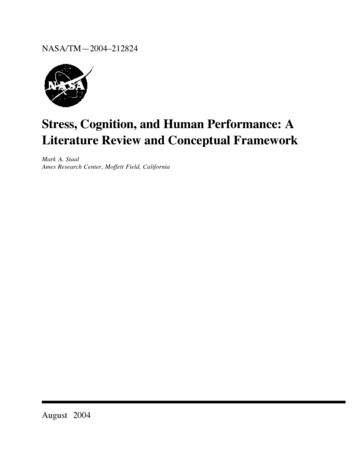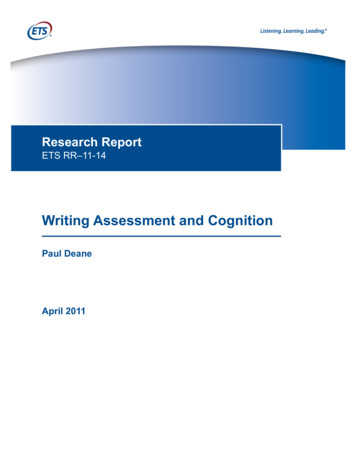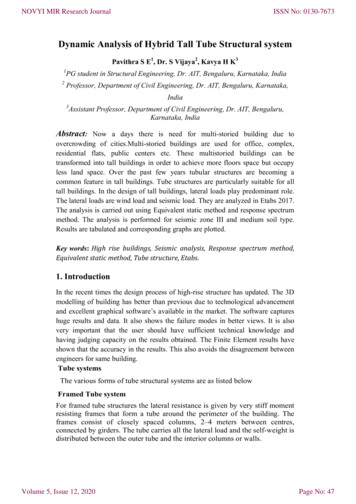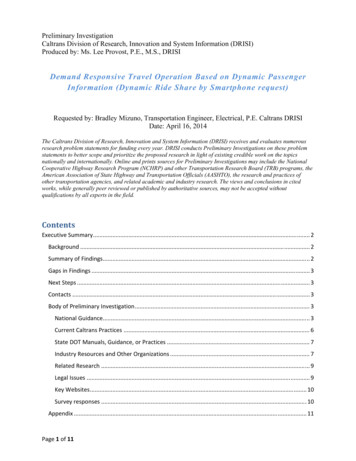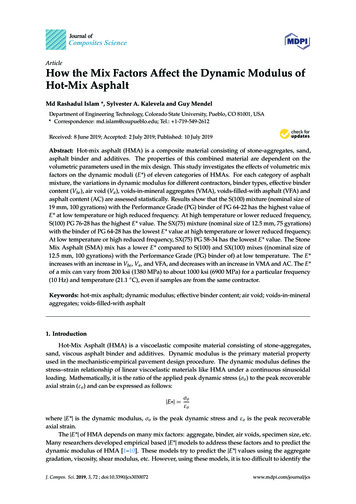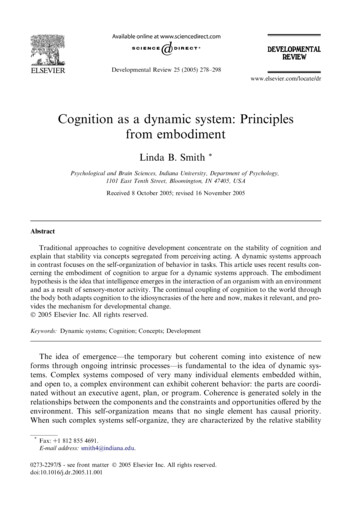
Transcription
Developmental Review 25 (2005) 278–298www.elsevier.com/locate/drCognition as a dynamic system: Principlesfrom embodimentLinda B. Smith*Psychological and Brain Sciences, Indiana University, Department of Psychology,1101 East Tenth Street, Bloomington, IN 47405, USAReceived 8 October 2005; revised 16 November 2005AbstractTraditional approaches to cognitive development concentrate on the stability of cognition andexplain that stability via concepts segregated from perceiving acting. A dynamic systems approachin contrast focuses on the self-organization of behavior in tasks. This article uses recent results concerning the embodiment of cognition to argue for a dynamic systems approach. The embodimenthypothesis is the idea that intelligence emerges in the interaction of an organism with an environmentand as a result of sensory-motor activity. The continual coupling of cognition to the world throughthe body both adapts cognition to the idiosyncrasies of the here and now, makes it relevant, and provides the mechanism for developmental change.Ó 2005 Elsevier Inc. All rights reserved.Keywords: Dynamic systems; Cognition; Concepts; DevelopmentThe idea of emergence—the temporary but coherent coming into existence of newforms through ongoing intrinsic processes—is fundamental to the idea of dynamic systems. Complex systems composed of very many individual elements embedded within,and open to, a complex environment can exhibit coherent behavior: the parts are coordinated without an executive agent, plan, or program. Coherence is generated solely in therelationships between the components and the constraints and opportunities offered by theenvironment. This self-organization means that no single element has causal priority.When such complex systems self-organize, they are characterized by the relative stability*Fax: 1 812 855 4691.E-mail address: smith4@indiana.edu.0273-2297/ - see front matter Ó 2005 Elsevier Inc. All rights reserved.doi:10.1016/j.dr.2005.11.001
L.B. Smith / Developmental Review 25 (2005) 278–298279or instability of their states. These ideas have been used to explain a variety of phenomenain the physical and biological world, and increasingly they have been used—as this volumeattests—in the study of developmental process.These foundational tenets of a dynamic systems approach have particularly radicalimplications for how we think about cognition. In particular, they imply each that thoughtis an in-the-moment unique event, open to a continually changing world, and the productof the intrinsic dynamics of a nonstationary system. Yet concepts, nonchanging symbolicor propositional representations, are the core theoretical construct in contemporaryresearch on cognitive development, and are seen as essential to explaining the stabilityof human cognition. As Keil (1994, p. 169) wroteShared mental structures are assumed to be constant across repeated categorizationsof the same set of instances and different from other categorizations. When I thinkabout the category of dogs, a specific mental representation is assumed to be responsible for that category and roughly the same representation for a later categorizationof dogs by myself or by another.This traditional cognitivist approach segregates constant concepts from the real time andinherently variable processes of perceiving and acting, the province of dynamic systems.These ideas of concepts and representations—ideas that have done considerable work in theystudy and explanation of cognitive development—seem completely at odds with dynamicsystems notions. If we pursue a dynamic systems approach, do we then discard concepts?The present paper reviews evidence pertinent to three principles concerning how knowingis bound to the world through body. The evidence and the principles all concern what hasbecome to be known as the embodiment hypothesis. The embodiment hypothesis is the ideathat intelligence emerges in the interaction of an organism with an environment and as aresult of sensory-motor activity. The findings about embodiment derive from computational(e.g., Beer, 2000), behavioral (Bahrick & Lickliter, 2000; Zwaan, Stanfield, & Yaxley, 2002),and neuroscience (Kan, Barsalou, Solomon, Minor, & Thompsonschill, 2003; Knudsen,2003; Stein & Meredith, 1993) perspectives on cognition to cognition suggest instead thatall knowledge may be emergent from, embedded in, distributed across, and inseparable fromreal time processes of perceiving, remembering, attending, and acting (Samuelson & Smith,2000; see also, Barsalou, Simmons, Barbey, & Wilson, 2003; O’Regan & Noë, 2001). Not allthe proponents of this new view explicitly use the vocabulary and formalisms of dynamicsystems. Nonetheless, they share the idea that cognition just is a complex set of internal processes bound to each other and to the world through perception and action in real time withno fixed and segregated representation of anything, that is, that cognition just is a complexdynamic system. This paper selectively reviews the evidence and the implications of embodiment for a dynamic systems theory of cognitive development. The evidence and theoreticalconcepts promise a deep new understanding of both cognition and developmental change,and it is the positive contribution of this approach that is the main thesis of this paper. However, lurking in the background throughout is the problem of concepts. Taking a dynamicsystems approach to cognition requires thinking about cognition in entirely new ways.Thought is an in-the-moment event tied to the here and nowThe rationale for concepts is that constants in the head are required to explain stabilityin behavior. But just how stable is behavior really? Contrary to Keil’s example, we do not
280L.B. Smith / Developmental Review 25 (2005) 278–298think exactly the same thing each time we think of dog—in the context of frisbies, we thinkof playful puppies, in the context of race tracks, we think of streamlined (and not a bitplayful) greyhounds, and in the context of muzzles, the main thought is fear. Thoughtsare relevant and adaptive only if they fit the relevant idiosyncrasies of the here andnow. This is the main thesis of this section and the case will be made with respect tothe object concept as proposed by Piaget (1963). But first, I begin with an example frommotor development that presents the essence of the argument in barebones form in adomain in which concepts are not in question. Instead, the issue concerns another hypothetical construct, the central pattern generator that like concepts is proposed to explainstability.The stable behavior is the alternating limb pattern that characterizes the walking pattern of four-legged mammals such as cats. Classic theories in motor behavior explainedthe stable patter by a central pattern generator (CPG). There seemed too much supportfor the idea. For example, investigators (e.g., Delcomyn, 1980) found that cats would walkwith alternating limbs on a treadmill even when their spinal cords were surgically separated from their brains. The conclusion from this was that the CPG was in the spinal cord.The validity of the a CPG has been questioned on many grounds (see Thelen & Smith,1994) but the central point here is that even if a CPG did exist, it could not be the causeof the stability apparent in the alternating limb action of real cats walking across real terrains. Real cats walk backward, forward, on grass, on hills, on rubble. They side stepobjects; they walk when one limb is in a cast. The alternating limb pattern in apparentin all these cases but the variability to make this same pattern is remarkable. Alternatinglimb movement in these different contexts requires fundamentally different patterns ofmuscles firing to maintain the same global stability of alternation. Yet the CPG is a supposed constant. If such a CPG exists, then processes outside of this structural constantmust make walking happen in globally similar but appropriately different ways in all thesecontexts. This is the central failure of explaining stability in behavior across contexts witha constant stability in the head. If what is in the head is constant, then the real work ofbehaving and knowing in the moment, of adapting to the specific demands of the hereand now, must be outside of these constant constructs. If this is so, why propose such constants at all? The point: the CPG is irrelevant to explaining the stability and the variabilityof real time behavior and the explanation of real time behavior can only be found in theprocesses that bind the system to the physical world. In what follows, I argue that in thesame way the hypothetical construct of a CPG is irrelevant to explaining the alternatingpattern in four-legged walking, so the object concept irrelevant to explaining the stabilitiesand instabilities in infants search for hidden objects.Piaget (1963) defined the object concept as the belief that objects persist in space andtime independent of one’s own perceptual and motor contact with them. Piaget measuredinfants’ ‘‘object concept’’ in a simple object-hiding task. It works like this: the experimenter hides a tantalizing toy under a lid at location A. After a delay (typically 3–5 s), theinfant is allowed to reach and most infants do reach to A and retrieve the toy. This A-location trial is repeated several times. Then, there is the crucial switch trial: the experimenter hides the object at a new location, B. Infants watch the object being hidden at the newlocation. But after the delay, if the infants are 8- to 10-months old, they make a characteristic ‘‘error’’, the so-called A not B error. They reach not to where they saw the objectdisappear, but back to A, where they found the object previously. Importantly, infantsolder than 12 months of age usually search correctly on the crucial B trials (see Wellman,
L.B. Smith / Developmental Review 25 (2005) 278–2982811986). Piaget suggested that this pattern indicated that older infants but not younger onesknow that objects can exist independently of their own actions. There has, of course, beenmuch debate about this conclusion and many relevant experiments pursuing a variety ofalternatives (Acredolo, 1979; Baillargeon, 1993; Bremner, 1978; Diamond, 1998; Munakata, 1998; Spelke & Hespos, 2001), including that infants much younger than those thatfail the traditional A not B task do—in other tasks—represent the persistence of the objectbeyond their own perceptual contact.In this context of divergent views on the phenomenon, Smith, Thelen and colleagues(Smith, Thelen, Titzer, & McLin, 1999; Spencer, Smith, & Thelen, 2001; Thelen & Smith,1994; Thelen, Schoner, Scheier, & Smith, 2001), sought to understand infants’ behavior inthe task. At the behavioral level the task would seem to be about reaching to the rightlocation in visual space; hence, these researches sought to understand infants failuresand successes in the task in terms of visually guided reaching. In the task, infants lookat objects at particular locations, and then—repeatedly—reach to those locations. Fromthe perspective of visually guided reaching, the key components of the task can bedescribed analyzed as illustrated in Fig. 1. The infant watches a series of events, the toybeing put into a hiding location and then covered with a lid. From this, the infant mustformulate a motor plan to reach and must maintain this plan over the delay, and then execute the plan. Smith, Thelen and colleagues argue that competence that underlies success(or failure) in this task is embedded in the real time processes that create actions in theworld. Their explanation—of both failure and success in the task—includes no constructanything like an object concept. One might conclude from this that the A not B task justdoes not happen to tap—is not relevant to—an object concept. But Smith and Thelen’sidea is more radical than that: the motor plan, necessary in any account of infants’ actualperformance in this task, in and of itself, implements a ‘‘belief’’ on the part of the systemthat objects persist in space and time. In this way, sensory-motor processes create aFig. 1. A task analysis of the A not B error, depicting a typical A-side hiding event. The box and hiding wellsconstitute the continually present visual input. The specific or transient input consists of the hiding of the toy inthe A well. A delay is imposed between hiding and allowing the infant to search. During these events, the infantlooks at the objects in view, remembers the cued location, and undertakes a planning process leading to theactivation of reach parameters, followed by reaching itself.
282L.B. Smith / Developmental Review 25 (2005) 278–298stability in the system that from the outside might look like a belief about objects but thatis instead embedded in—not mediating between—processes of perceiving and acting.These ideas lie at the core of Thelen et al.’s (2001) formal dynamic systems account ofthe A not B error. The theory specifies the sensory events and their dynamic integration inthe formation (and maintenance over the delay) of a reaching plan. The theory is illustrated in schematic form in Fig. 2. The center figure illustrates the activation that is a plan tomove the hand and arm in a certain direction. Three dimensions define this motor planning field. The x-axis indicates the spatial direction of the reach, to the right or left.The y-axis indicates the activation strength; presumably this must pass some thresholdin order for a reach to be actually executed. The z-axis is time. All mental events occurin real time, with rise times, durations, and decay times. In brief, the activation in the fieldthat is the plan to reach evolves in time as a function of the sensory events, memory, andthe field’s own internal dynamics.According to theory, activation in this field is driven by three inputs to the field. Thefirst is the continually present sensory activation due to the two covers on the table. Thesedrive activation (perhaps below a reaching threshold) to those two locations because thereis something to reach to at those locations. The second input is the hiding event that instigates a rise in activation at the time and location of the hiding of the object. It is this activation from this specific input that must be maintained over the delay if the infant is toreach correctly on B trials. The third input is the longer-term memory of the previousreaches which can perturbs the evolving activation in the field, pulling it in the directionof previous reaches.Fig. 3 shows results from simulations of the model. Fig. 3A illustrates the evolution ofactivation in the hypothesized motor planning field on the very first A trial. Before theFig. 2. An overview of the dynamic field model of the A not B error. Activation in the motor planning field isdriven by the tonic input of the hiding locations, the transient hiding event, and the memories of prior reaches.This figure shows a sustained activation to a hiding event on the left side despite recent memories of reaching tothe right, that is a nonperseverative response.
L.B. Smith / Developmental Review 25 (2005) 278–298283Fig. 3. (A) The time evolution of activation in the planning field on the first A trial. The activation rises as theobject is hidden and due to self-organizing properties in the field is sustained during the delay. (B) The timeevolution of activation in the planning field on the first B trial. There is heightened activation at A prior to thehiding event due to memory for prior reaches. As the object is hidden at B, activation rises at B, but as thistransient event ends, due the memory properties of the field, activation.
284L.B. Smith / Developmental Review 25 (2005) 278–298infant has seen any object hidden, there is low activation in the field at both the A and Blocations that is generated from the perceptual input of the two hiding covers. As theexperimenter directs attention to the A location by hiding the toy; that perceived eventproduces high transient activation at A. The field evolves and maintains a planned reaching direction to A. This evolution of a sustained activation peak that can drive a reacheven after a delay, even when the object is hidden, is a consequence of the self-sustainingproperties of the dynamic field. Briefly, the points within a field provide input to oneanother such that a highly activated point will exert a strong inhibitory influence overthe points around it, allowing an activation to be maintained in the absence of externalinput.One crucial aspect of this dynamic field account is that once infants reach, a memory ofthat reach becomes another input to the next trial. Thus, at the second A trial, there isincreased activation at site A because of the previous activity there. This combines withthe hiding cue to produce a second reach to A. Over many trials to A, a strong memoryof previous actions builds up. Each trial embeds the history of previous trials. Fig. 3B illustrates the consequence of this on the critical B trial. The experimenter provides a strongcue to B. by hiding the object there. But as that cue decays, the lingering memory ofthe actions at A begin to dominate the field, and indeed, over the course of the delaythrough the self-organizing properties of the field itself activation shifts back to the habitual, A side. The model predicts that the error is time dependent: there is a brief periodimmediately after the hiding event when infants should search correctly, and past researchshows that without a delay, they do (Wellman, 1986).The model makes a number of unexpected predictions that have been tested in a varietyof experiments (see Thelen et al., 2001). Indeed, simulations from the model an be used todesign experimental manipulations that cause 8- to 10-months olds to search correctly onB trials and that cause 2- to 3-years old to make the error (Spencer et al., 2001) utility ofthis model is confirmed by the fact that it can be used to design experimental manipulations that cause babies to make and not make the error. These effects are achieved bychanging the delay, by heightening or lessening the attention-grabbing properties of thecovers or the hiding event, and by increasing and decreasing the number of prior reachesto A (Diedrich, Highlands, Spahr, Thelen, & Smith, 2001; Smith et al., 1999). What dothese effects mean about the object concept? Does such a concept have any role to playin explaining behavior—or like the construct of a CPG is the object concept irrelevantto explaining how infants actually do or do not search at B on B trials? What is knowing?Do 10-months old infants know something different when they make the error comparedwith when they do not? In the moment, they clearly do, and this is what the model seeks toexplain: A decision to reach to find the toy emerges in the moment from multiple components in relation to the task and to the immediately preceding activity of the system. Fromthis perspective of the in-the-moment behavior, there may be no single cause, no singlemechanism and no one ‘‘concept’’ that distinguishes 10-months old from 12-months oldor 2-years old in this task. Instead, there may be many contributing processes that makeknowing in the moment and thus that make the error appear and disappear. Ten-monthsold, 12-months old, and 2-years old, can be regarded as complex systems that self-organizein specific tasks through processes of perceiving, acting, and remembering. The object concept as it is usually conceived seems to have nothing to do with it.In the dynamic field model, the processes that underlie the behavior—the activations inthe dynamic field—are conceptualized as motor plans. Indeed, by this account, it is the
L.B. Smith / Developmental Review 25 (2005) 278–298285maintenance of a motor plan to reach to the most recently seen hiding location that differentiates between infants who make the error and those who do not. We have strong evidence for this claim that the relevant processes are
explain that stability via concepts segregated from perceiving acting. A dynamic systems approach in contrast focuses on the self-organization of behavior in tasks. This article uses recent results con-cerning the embodiment of cognition to argue for a

